 

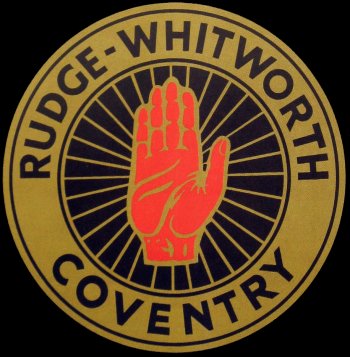

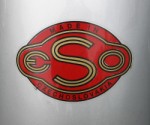


 |
|
|
|
|
|
|
|
Bikes Page 3
|
| |
| |
|
Bikes Page 1 Bikes Page 2
Bikes Page 4 Bikes
Page 5
Bikes Page 6
Bikes Page 7
|
| |
| |
|
| |
| |
|
JAWA |
| |
| Dave Gifford ex Newcastle now back in his native New Zealand has
sent these pictures of a meticulously restored machine. Dave has other
projects in mind and I will badger him for updates on his restoration works.
So watch out Giffy I am on your case mate, get that camera charged up. |
| |
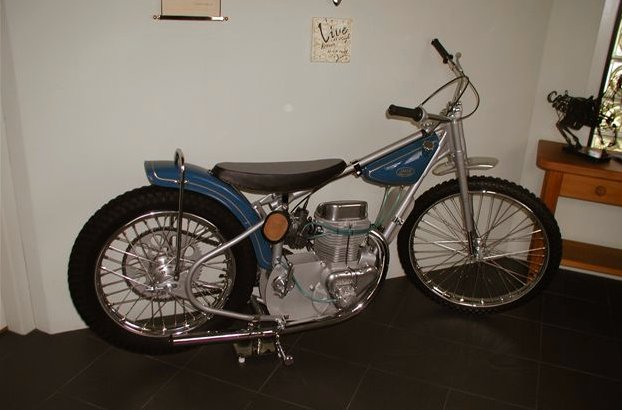 |
| |
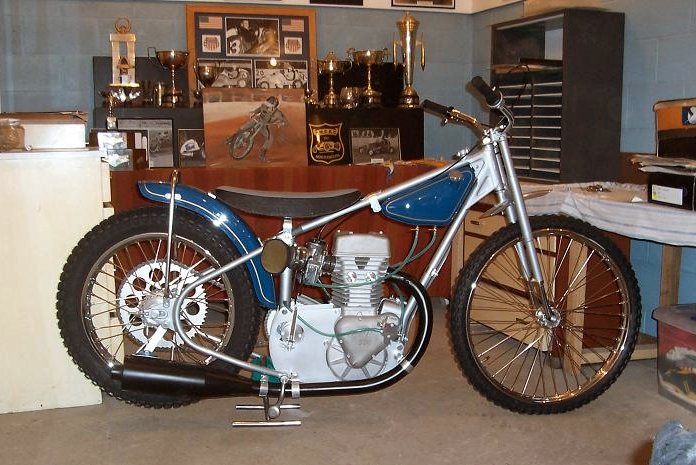 |
| |
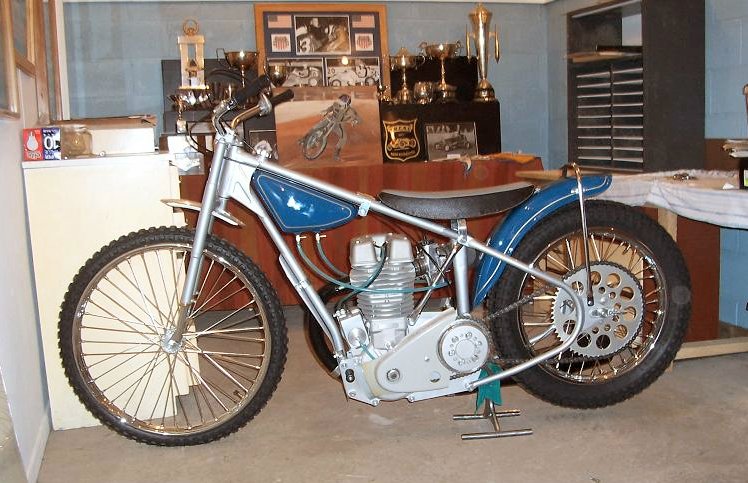 |
| |
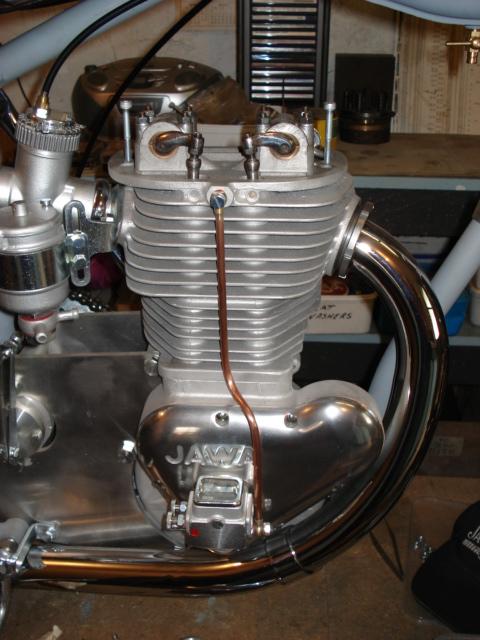 |
| |
|
I will ask Giffy for information re these pictures but
isn't it clear that he has real skills at restoration work? I will bet the
bike looks better after Dave's work on it than it did when it left the JAWA
factory
|
| Giffy says:
Hi John, re the photos. The two pics of the twin cam, Jawa 1976 model 894 4
valve twin cam. The motor is a Jawa model 890 and is the last of this design
and has two more crankcase webs than the earlier two valves. Joes bike is the
same, a late model Jawa 890. |
| |
|
| |
| |
|
Remote Float Bowl
|
| |
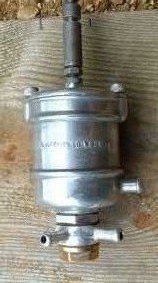 |
| |
|
Same as shown on the Jawa?
|
| |
|
Andy Stimson says: Hi John, In
picture 4 of the "Bikes 3" page (the Jawa engine close up), it shows the
remote float.... I have this float on my Triton, and have spent a couple
of years trying to identify the make and model.. would be extremely
grateful for any information to put my mind at rest ! I have been told by
an ex-speedway rider that it might be grasstrack/speedway but unable to
confirm.
Here's a picture of my float
(See above)... Kind regards, Andy Stimson
|
| Hi Andy, please send a couple of pics of your Triton
John |
| |
|
Finland's Harry Lahti says: Hi John, I was looking at your fine
speedway pages, and found a question without an answer on your Bikes
Page 3. The float is an ESO/JAWA float for speedway used at
least up to 1969. Best regards, Harry Lahti, Finland
|
| |
| The Triton - Bits In A Box! |
| |
.jpg) |
|
Courtesy of Andy Stimson |
| |
|
A box of bits; one week after Andy bought the "Triton" which for
the uninitiated is a Triumph engine housed in a Norton Featherbed frame.
Seen as the ultimate machine in the 1960's and early 1970's until Honda headed
the Japanese invasion. The early Japanese bikes, great as they were, have
"been and gone", but the Triton still turns heads
|
| |
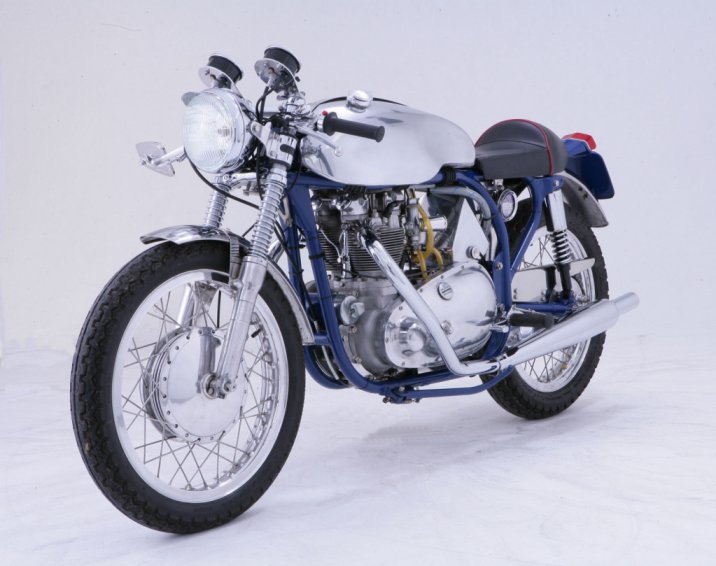 |
| |
.JPG) |
|
Courtesy of Andy Stimson
|
| |
| From a box of bits to this gleaming beauty. Well done Andy
mate! Your Triton looks amazing. Can anyone put a name to the float
chamber used on Giffy's Speedway Jawa and Andy's Road-Going Triton?
John |
| |
|
| |
| |
| Velocette |
| |
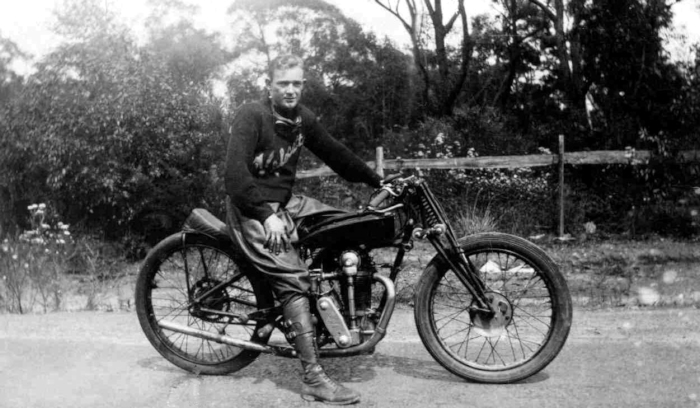 |
| |
| Velocette was a great British bike company that
dabbled a little bit in the dirt track/speedway market. In a world
of 500cc speedway bikes Velocette came up with a 400cc engine.
Surely underpowered and maybe it shows that the company were not that
concerned about making speedway bikes? |
| |
|
| |
| |
| Argentina 1920s Bike |
| |
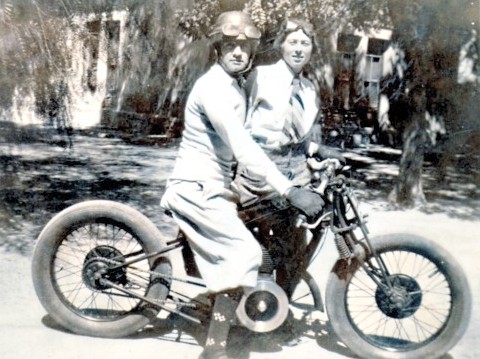 |
| Courtesy of Argentinian "Anibal" |
| |
| I received the above image from
Anibal who is one of my websites regular Argentinian visitors. He has
this photograph of a stripped down bike which he thinks
could be a 1926 AJS and the photo may have been taken
around 1930. I do not recognise the bikes main
feature, the large flywheel but maybe my knowledge of early AJS engines
is lacking? Can anyone confirm it is an old AJ or identify the
actual make of machine?
John The
bike must have been an accident waiting to happen! I dread to
think what injuries it would have caused if the rider had been knocked
backwards between the saddle and the back wheel at speed. |
| |
|
| |
| |
| Early 1930s Rudge |
|
|
 |
|
|
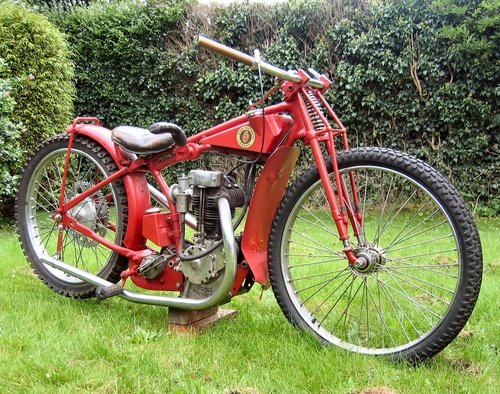 |
| |
|
Circa 1930 this is a beautifully
restored 500cc Rudge Whitworth Dirt Track machine. The
Rudge had a relatively short span as a speedway bike. 1929
saw the Douglas DT monopolise the winners rostrums but Rudge did a
similar thing in 1930. The bike's importance should not be
overlooked as the engine and frame designs must have been
influences on another British bike maker John Alfred Prestwich or
JAP. The JAP that came in into the arena in 1931 was very
similar to the Rudge but Mr Prestwich's machines wiped the floor
with Rudge and Douglas which is a pity as Douglas and Rudge could
have rivalled the JAP for longer than a couple of years if they
had really wanted to. |
| |
|
| |
| |
| AJW JAP |
| |
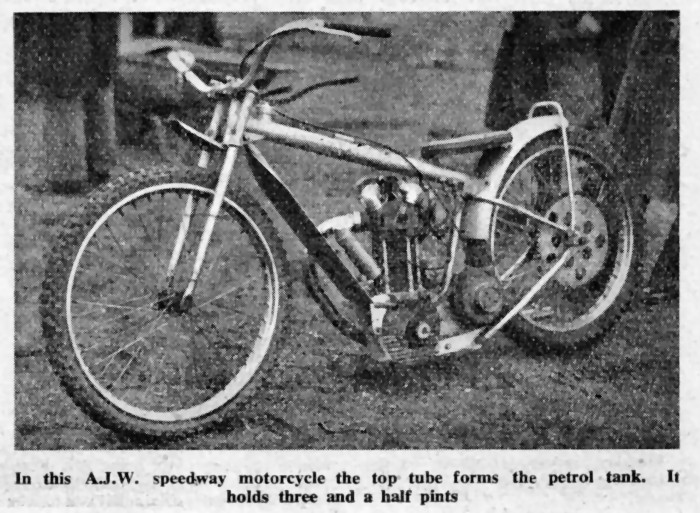 |
| Courtesy of David Pipes |
| |
| AJW stands for Arthur John
Wheaton and JAP refers to John Alfred Prestwich. Wheaton made
frames and Prestwich made the JAP engines. This picture shows the
innovation of AJW in making a frame with a top tube to replace the fuel
tank. It seemed such a good idea, I wonder why it didn't catch on
in speedway? If you have any information on this matter please
send me an email John |
| |
| |
A Conventional AJW/JAP
Machine |
| |
 |
| |
| There is no doubt that a bike frame made by AJW
or any other company looks better with a fuel tank so maybe AJW's Top
Tube Fuel Tank was simply rejected for cosmetic reasons? |
| |
|
| |
| |
British Made Engine
Don Godden
4 Valve |
| |
 |
| |
|
Don Godden with his innovative 4 valver, 4 valve engines have now become
the norm
|
| |
|
| |
| |
| Excelsior JAP |
| |
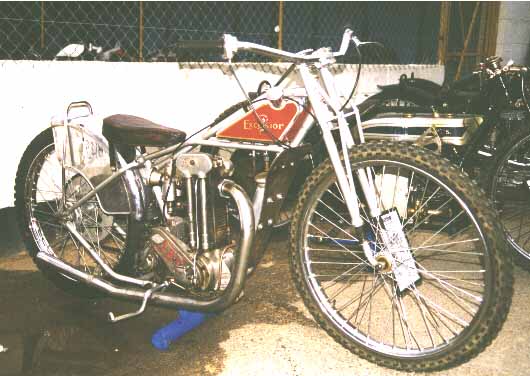 |
|
Photo
by Steve Magro, Australia.
http://homepages.ihug.com.au/~stvmagro/ |
| |
|
Excelsior made great frames and JAP great engines in the days
when British was best
|
| |
|
| |
| |
| The Mighty JAP Engine |
| |
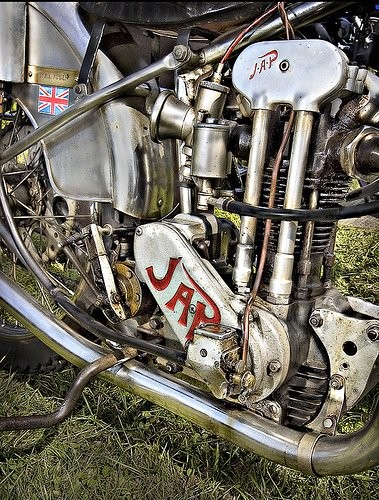 |
| |
| A nice clean picture of a JAP engine. The
two chromed tubes housed the pushrods on this long stroke engine.
I am a petrol head, so I love this picture. JAPs were at the high end of
engine technology for many years and their old engines are still
surprisingly quick. |
| |
|
Can anyone say what model and year this engine is
John : Terry Stone says the engine is a 4b what about the
year rough guess will do.
John
|
| |
|
| |
| |
Frank Varey Aboard
His
1929 Scott |
| |
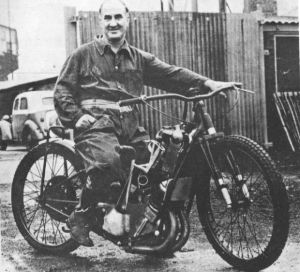 |
| |
| Frank Varey aboard his 1929 Scott. This
"ugly duckling" bike was a
water cooled 2-stroke and at that time Dirt Bikes had no silencing so the Scott must have
been deafening at full throttle. |
| |
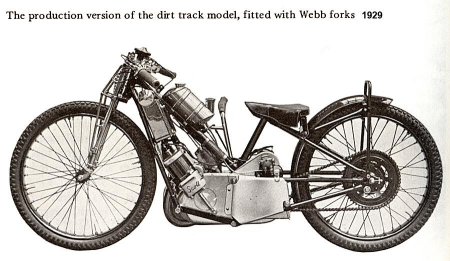 |
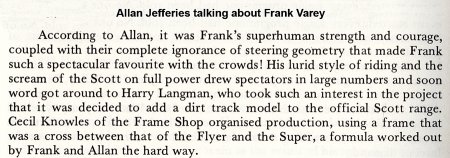 |
| |
|
| |
| |
|
Upright GM Italian Engined
Bike
From The 1980's
|
| |
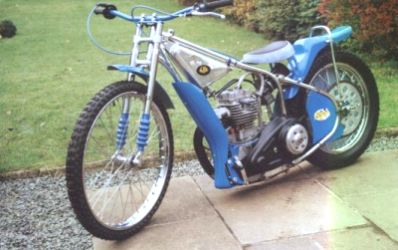 |
| |
GM are the initials of the company owner, Italian: Giuseppe
Marzotto
|
| |
|
| |
| |
| Ivan Mauger's Gold Bike |
| |
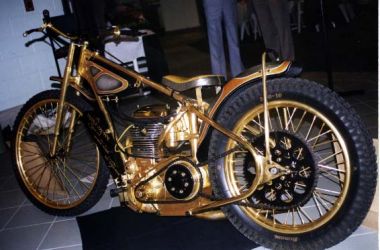 |
| |
| Ivan Mauger's gold plated bike. It is his 1970 Jawa. The bike was gold
plated as a result of him winning the triple world crown! Ivan was world champion in 1968, 1969 and 1970,
and before his third triumph in 1970 he was told that if he won a third world title on the
trot his bike should be given the "golden" touch. He won it, so
the bike got the treatment. |
| |
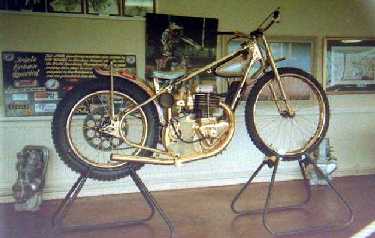 |
| |
|
| |
| |
|
Ice Racing
|
| |
|
I am on the lookout for details of these bikes and pictures
etc so get in touch if you have any.
|
| |
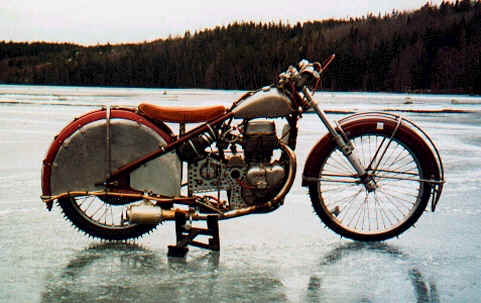 |
| |
| This Jawa Ice Racer has never been anywhere near
my beloved Tyneside,
despite the North East weather! But New Zealander Bruce Cribb did race
around Brough Park on a bike like it, His 4 lap time was incredible but then
again the spikes gave him a bit of an advantage. It was more like slot car
or scalextrix but great to watch. Do you have his heat times then? email me
John |
| |
|
Stu Towner says: The first ice racers were just speedway
bikes with spikes in the tyres, but they have seen much more
development than their speedway counterparts. These forks can be adjusted for
pressure by pumping up or down. They now have rear suspension albeit set quite
hard as the track gets very cut-up by the end of a meeting. They also tried
laydown engines but a lot have gone back to upright ones. |
| |
| Jim Miller USA used the above picture to
promote an Ice Racing event he took part in. Jim has been back in touch
and has kindly supplied the following 3 photographs which is more
motorcycles racing
on ice than Ice Speedway but I'll bet it's great anyway. |
| |
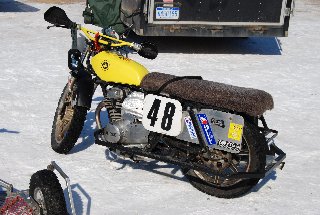
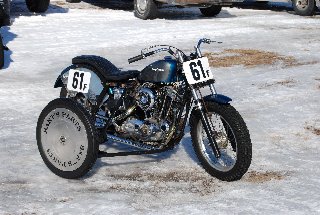 |
| |
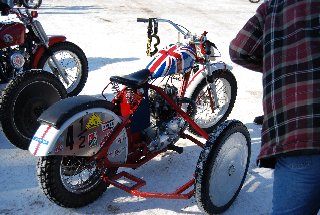 |
| |
| John says: It certainly looks interesting, pity the UK has no
outdoor Ice Racing. |
Jim says: -
The racing was excellent! We had perfect weather conditions - cold, sunny with
great ice. The turnout was especially good
|
|
John says: Thanks mate, if you want to tell us more about the bikes, feel
free
|
| |
|
| |
| |
| |
| "If Ivan Can Have A Gold Bike Then So Can I !" |
| |
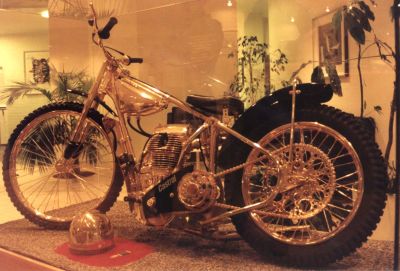 |
| |
| If Ivan can have a Gold Bike then so can I! Ole Olsen's bike
another Jawa but a year newer (1971) than Ivan's machine. Having seen both I would say Ole's is the nicer to look
at but as the saying goes "Beauty is in the eye of the beholder". |
| |
|
| |
| |
| Vic Ridgeon's Fully Chromed Rotrax
JAP |
| |
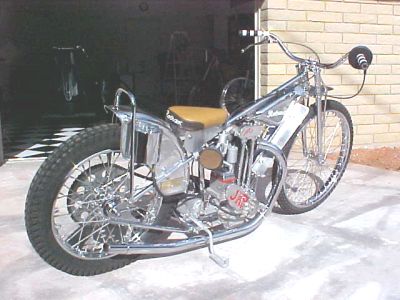 |
| |
| It is a pity that this photo is not crystal
clear as I think this is the most beautiful speedway bike I have come
across, It is Chrome, not your vulgar gold! (Sorry
Ivan and Ole). Vic Ridgeon's Rotrax JAP from the
1950's when they knew how to chrome plate a bike! |
| |
|
| |
| |
| The Vincent Vampire |
| |
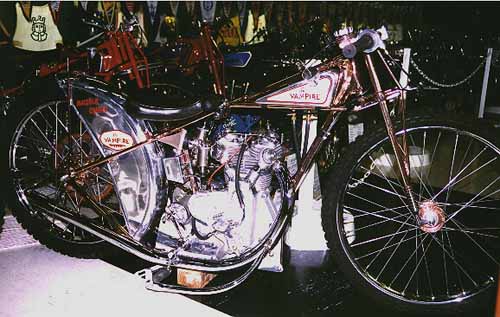 |
|
Photo
by Steve Magro, Australia.
http://homepages.ihug.com.au/~stvmagro/
|
| |
| Malcolm Craven's Vampire |
| |
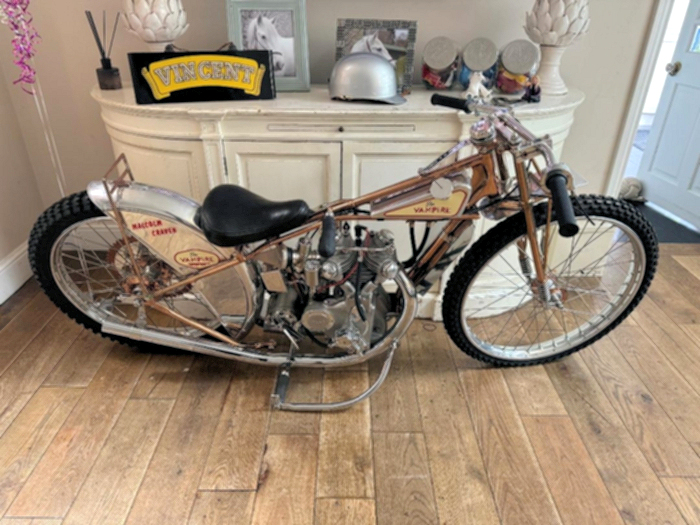 |
| |
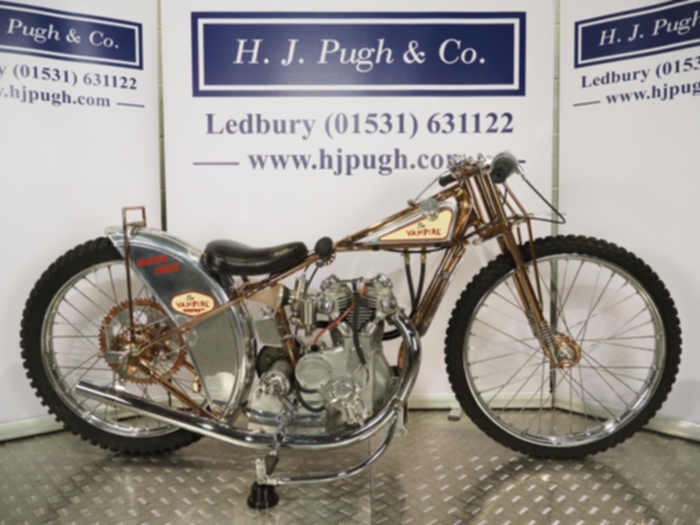 |
| |
|
Reg Fearman says: Information from Bert Harkins who was at the Sale
but unable to buy anything for the Speedway Museum. This H.R.D. was
owned by Ian Patterson of Edinburgh and was bought by a chap in
Reading for £15,000, Ian's collection was sold in July at the sale
rooms in Ledbury Herefordshire for over £1 million, it took two days
to transport from Edinburgh the machines and equipment. This HRD is
one of only two in the world, Eric Chitty raced one and Malcolm
Craven the other. You may be able to find on the web all of the
machines sold without reserve and the price made, the Auctioneers
details are on the other photo. A Huck Fynn sold £3200, the Indian
£55,000 Nigel Boocock Leathers £5,500, Simon Wigg and Erik Gunderson
Race Jackets £2000 plus. Everything mega money!!
Cheers, Reg
|
| |
| Bike fans who are old enough will tell you
about Vincent's 1000cc V Twins but the British company dabbled with a
500cc single cylinder machine for use in the late 1940s on the speedway
tracks. The speedway bike was known as the Vincent Vampire. |
| |
| |
|
Another Vincent Vampire
From The
Late 1940's
|
| |
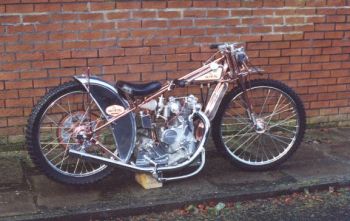 |
| |
| Us old bikers will tell modern bike owners that Vincent was the
Rolls Royce of the motorcycle world back in the 40s, 50's and 60's. Great pity
that this machine couldn't compete on the speedway scene because it was a great
British company. |
| |
|
| |
| |
1970's
ERM Jawa
(4 Valve Conversion) |
| |
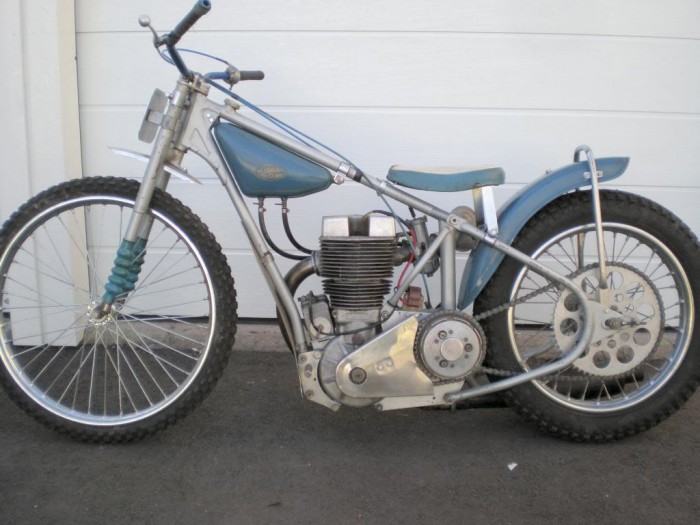 |
| |
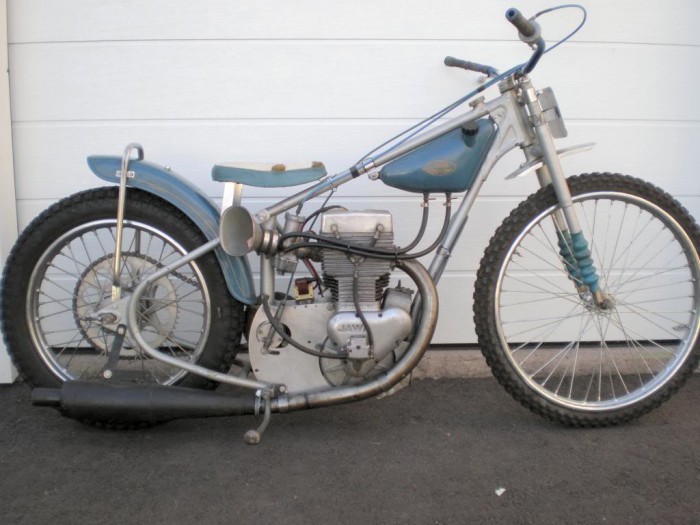 |
| |
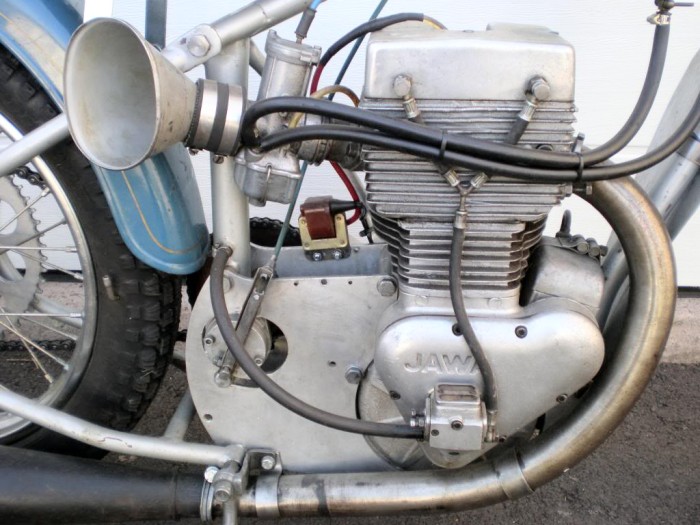 |
| |
| |
| John says: I understand that the Jawa had
a couple of early 1970's 4 valve conversions the above bike has the
Swedish ERM (Endfors Racing Motor) engine conversion..a four valve cylinder head. The ERM began
as the JJM (Jan Johanssen Motor) It was Jan Johannsen that designed
this DOHC 4V conversion in 1973. I am told Swede Christer Lofqvist used
the ERM (in fact a JJM) in the 1974 world final. I have heard of
German and Dutch Jawa 4 valve conversions but it wasn't until
Aussie Neil Street made his SRM Street 4 Valve Conversion ridden by his
son in law Phil Crump that the world took notice and within a few years
every speedway rider used a 4 valve engine. |
| If you can supply me with a timeline of 4 valve
conversions please send me an email
John |
| |
|
| |
| |
JAP Engined
Chater-Lea |
| |
| The use of copper components earned it the
nickname "Copperknob" Another engineering firm using JAP engines
in their frames. I am not certain but I think the Chater-Lea would
be from the 1920s! |
| |
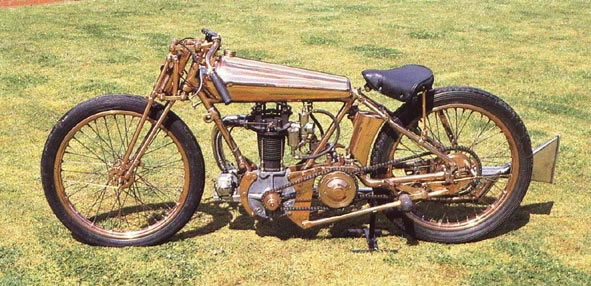 |
| |
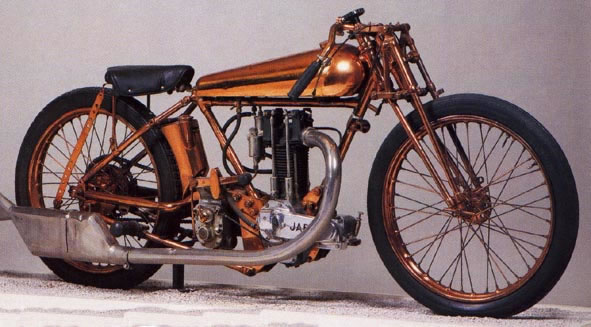 |
| |
|
Another view of the Chater-Lea Jap which was also know as the
Copperknob! Very doubtful that these bikes were raced on speedway tracks
but they do look the business. If the bike is from the 1920s and it was
used on a dirt track then JAP were a bit slow in cottoning on to speedway.
The first JAP speedway bike didn't appear til 1931ish!
|
| |
|
| |
| |
| Excelsior JAP |
| |
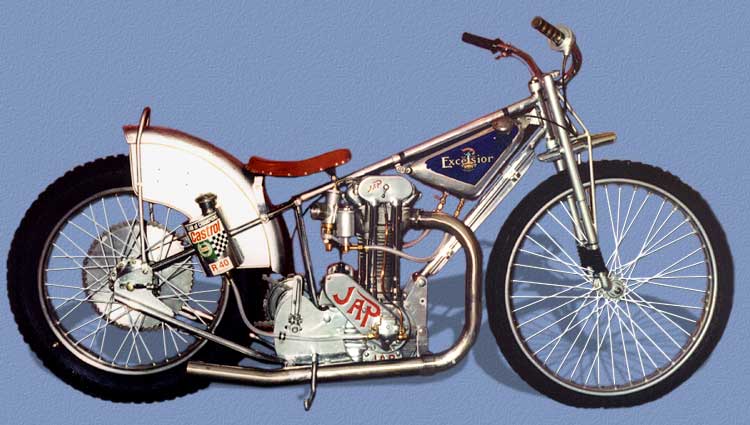 |
| |
| The oil tank on this bike has a Castrol R
sticker. I can almost smell it from here |
| |
|
| |
|
|
|
Weslake |
| |
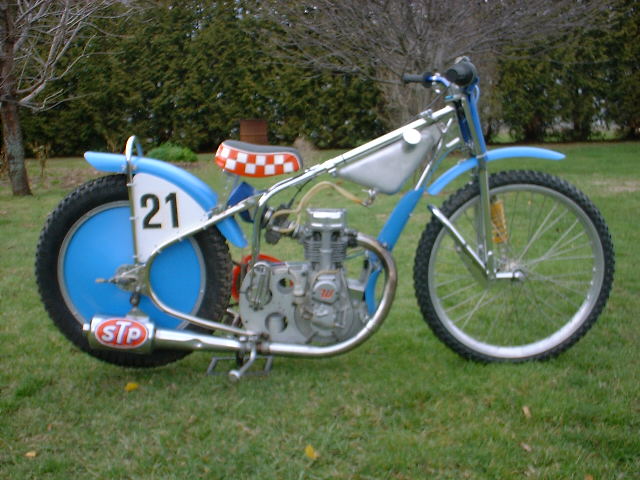 |
| |
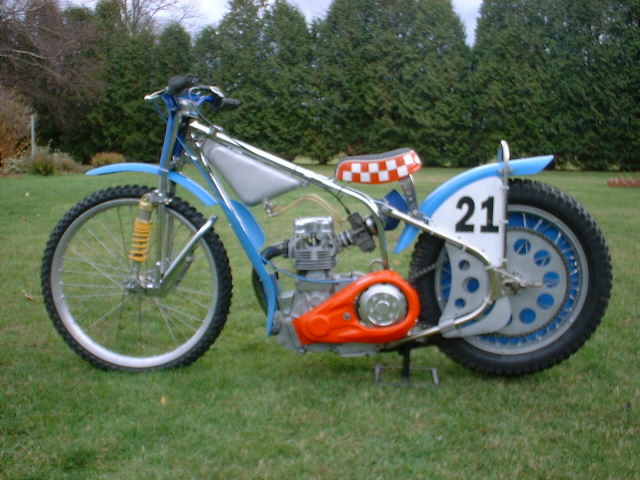 |
| |
| Weslake was another great British machine. They led the
way for a while from the late 1970's until mid 1980's when the Italian GM and
the Jawa took over. Jawa is the most successful bike in speedway history
(lasted the longest). It was a pity Weslake could not keep it
going as Jawa has now surpassed Britain's JAP by a number of years and
are still going strong. |
| |
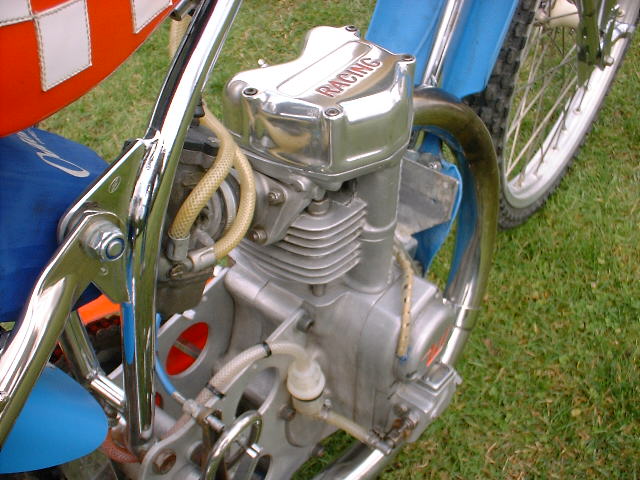 |
| |
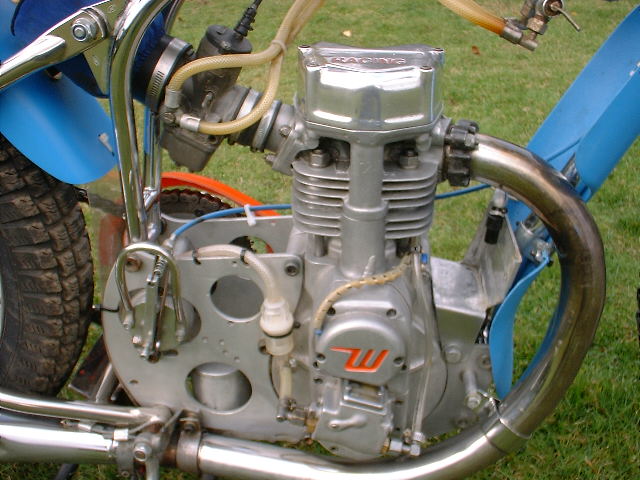 |
| What a beautiful machine! |
| |
|
This Weslake is in beautiful condition, it belongs to Philip
Small. He recently emigrated to Canada and is continuing his passion for the
sport over there. Your bike is spot on Phil mate!
|
| If you want to know more on the technical side visit Phil's
website
Phil's site and
I am sure he would be pleased to get a few emails from old blighty. |
Compare the above short Weslake engine to this
engine in the old technology Rotrax JAP.
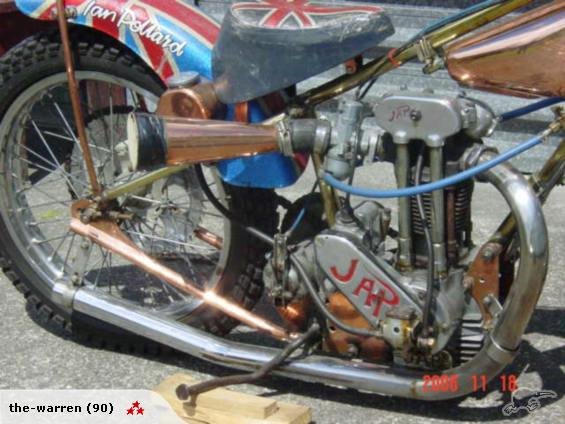 The
old JAPs had a very long stroke cylinder and the engine filled the
frame, by comparison the Weslake was very compact with a short stroke
cylinder. The JAPs power came from the torque it developed by the
huge punch down from its cylinder head, from the long stroke engine
cylinder. Whereas the Wessie's power came in due to it revving higher
than the JAP. Higher revving machines be they racing motorcycles
or cars are what is needed to get every inch of power out of a motor.
Formula 1 cars scream as the engines are revving so high. Speedway
lagged behind, relying on the older technology like the low revving JAP.
Modern speedway machines rev much higher than the JAP but still our
bikes get low down grunt from the single cylinder engines. The
old JAPs had a very long stroke cylinder and the engine filled the
frame, by comparison the Weslake was very compact with a short stroke
cylinder. The JAPs power came from the torque it developed by the
huge punch down from its cylinder head, from the long stroke engine
cylinder. Whereas the Wessie's power came in due to it revving higher
than the JAP. Higher revving machines be they racing motorcycles
or cars are what is needed to get every inch of power out of a motor.
Formula 1 cars scream as the engines are revving so high. Speedway
lagged behind, relying on the older technology like the low revving JAP.
Modern speedway machines rev much higher than the JAP but still our
bikes get low down grunt from the single cylinder engines. |
| John goes on to say: I am a motorbike fan
and a speedway nut. In my view, single cylinder engines should be
upright not laying down. Bikers can identify more with upright
speedway bikes and who wants to look at the boring modern engine fitted
as a lay down. Come on Jawa lead the way back to uprights for
artistic reasons eh! If anyone knows the history of the Weslake
please email me and I will put it here
John |
| |
|
| |
| |
Another of
Phil Small's
Weslake Machines |
| |
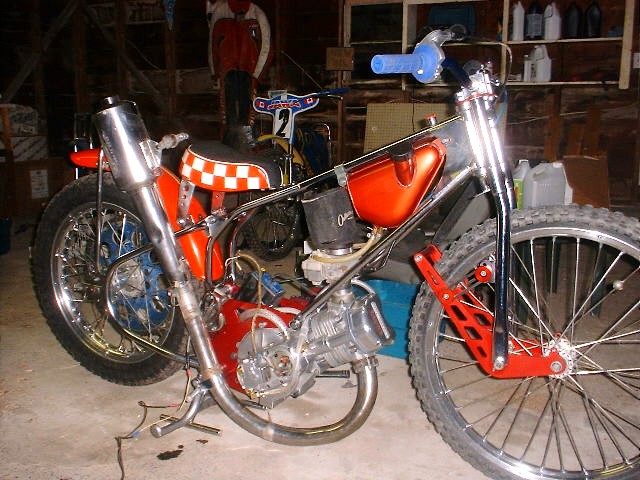 |
| |
| Weslake laydown! It looks awesome. The shape of things to come? maybe not! Surely
in a spill the pipe and silencer will take a hammering? I will ask Phil a few questions
about this bike. |
| Phil's response is below: - |
|
I thought that might come up as a topic of conversation
sometime! The exhaust is only there for test running the motor. I have not
fabricated the laydown exhaust header pipe yet, so I put the old upright
system on for testing only. It looked so hilarious I couldn't resist but to
post the picture!
Regards,
Phil #21
|
|
John says: Thanks Phil, so you hadn't gone mad after all. So how
does a laydown Weslake go? visit Phil's site to find out |
| |
|
| |
| |
|
Another JAP
|
| |
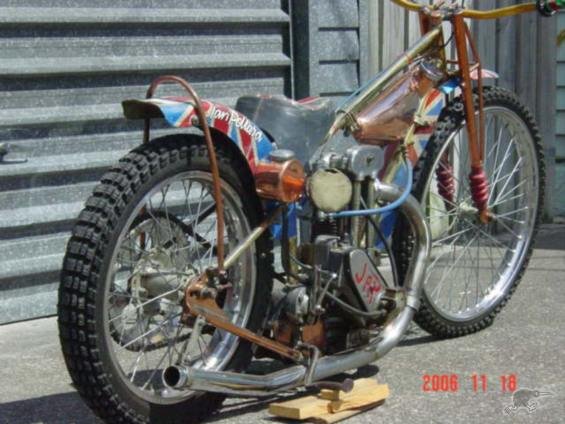 |
| |
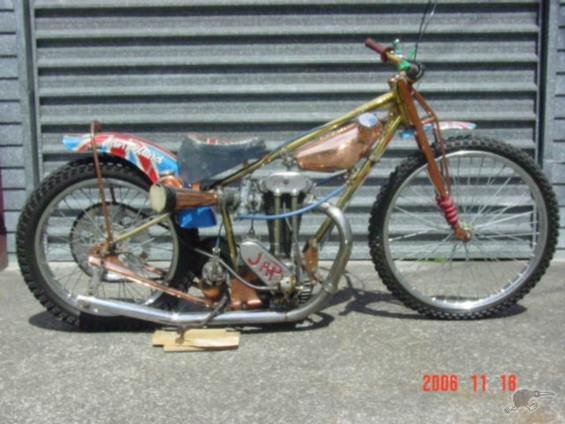 |
| |
 |
| |
| John Clegg says: Love your website. Attached are some pics of a bike
that was still in use up to 1979 here in NZ, basically it is a 1949 Rotrax JAP
which has been left in the condition it last raced. It still runs well, I
can't believe it has as much power as it does for such an old bike. They were
brave men. regards John Clegg. Thanks
John the bike looks superb. bring back the JAP |
| John
Skinner says: Well it is low revs and high torque v high revs.
Progress eh? The BSA Road Rocket was a low revving 500cc single
cylinder and it did 70mph in first gear. So that engine should
have been tried out for speedway as our bikes do not reach 70mph |
| |
|
| |
|
Bikes Page 1 Bikes Page 2 Bikes Page 4
Bikes
Page 5 Bikes Page 6 Bikes Page 7
|
| |
|
|
The contents of this website are © and should not be produced
elsewhere for financial gain. The contributors to this website
gave the pictures and information on that understanding. If anyone
has any issue or objections to any items on my website please email me
and I will amend or remove the item. Where possible credit has
been given to the owner of each item. |










.jpg)


































 The
old JAPs had a very long stroke cylinder and the engine filled the
frame, by comparison the Weslake was very compact with a short stroke
cylinder. The JAPs power came from the torque it developed by the
huge punch down from its cylinder head, from the long stroke engine
cylinder. Whereas the Wessie's power came in due to it revving higher
than the JAP. Higher revving machines be they racing motorcycles
or cars are what is needed to get every inch of power out of a motor.
Formula 1 cars scream as the engines are revving so high. Speedway
lagged behind, relying on the older technology like the low revving JAP.
Modern speedway machines rev much higher than the JAP but still our
bikes get low down grunt from the single cylinder engines.
The
old JAPs had a very long stroke cylinder and the engine filled the
frame, by comparison the Weslake was very compact with a short stroke
cylinder. The JAPs power came from the torque it developed by the
huge punch down from its cylinder head, from the long stroke engine
cylinder. Whereas the Wessie's power came in due to it revving higher
than the JAP. Higher revving machines be they racing motorcycles
or cars are what is needed to get every inch of power out of a motor.
Formula 1 cars scream as the engines are revving so high. Speedway
lagged behind, relying on the older technology like the low revving JAP.
Modern speedway machines rev much higher than the JAP but still our
bikes get low down grunt from the single cylinder engines.


